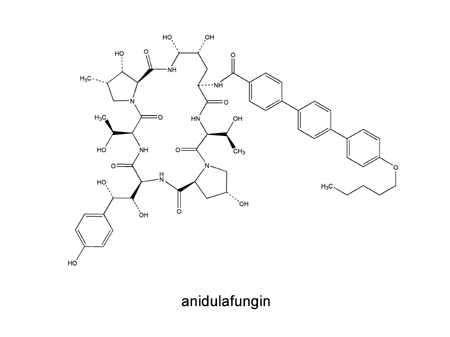Anidulafungin (Praxis®)
Manufacturer’s Prescribing Information
Trade & Generic Names & General Features
Anidulafungin (previously known as LY303366 and briefly also referred to as VER-002 and V-echinocandin) is a glucan synthase inhibitor of the echinocandin structural class. It is composed of the echinocandin B nucleus with a terphenyl head group and a C5 tail.
Anidulafungin was initially developed by Eli Lilly Pharmaceuticals. It was subsequently licensed to Versicor for development as a parenteral agent and the name of the manufacturing company thereafter changed to Vicuron. Pfizer acquired the drug upon its acquisition of Vicuron in the fall of 2005. It received FDA approval in February of 2006.
Anidulafungin is marketed under the brand name Eraxis in the U.S. and Ecalta in Europe.

Mechanism(s) of Action
As with other echinocandins, anidulafungin blocks the synthesis of a major fungal cell wall component, 1-3-beta glucan, via inhibition of 1,3-beta-glucan synthase.
Susceptibility Patterns
Anidulafungin is active in vitro against Candida spp. However, anidulafungin MICs for C. parapsilosis and C. guilliermondii are relatively higher than those for the other species similar to other echincandins against these species. It has been shown to be fungicidal against isolates of C. albicans and C. glabrata.
Anidulafungin does not have significant activity against Cryptococcus neoformans. Similarly, its activity against Blastomyces dermatitidis, Sporothrix schenckii, Trichosporon beigelii, Acremonium strictum, Rhizopus arrhizus, Fusarium spp. and Phialophora spp. is limited. Anidulafungin MICs for Histoplasma capsulatum, Cladophialophora bantiana, Pseudallescheria boydii, and Bipolaris spp. are also relatively high [683] [2276].
As with caspofungin, activity of anidulafungin against Aspergillus spp. has been investigated by using a distinctive parameter, “minimum effective concentration” (MEC), as well as MIC [1269]. Anidulafungin MECs for Aspergillus are in an acceptable range and lower than the MICs [1780] [1670].
For anidulafungin MICs obtained for various types of fungi, see susceptibility patterns and the N/A(L):susceptibility database.
Usual Doses
Esophageal candidiasis- 100 mg day#1, then 50 mg/day
Candidemia- 200 mg day#1, then 100 mg/day
Side-Effects
Clinical studies
Anidulafungin (100 mg day#1, then 50 mg/day) was compared to fluconazole (200 mg/day)in a randomized double-blind trial in 601 patients with esophageal candidiasis. Endoscopi success rates (were similar between the two treatments (97.4% vs. 98.7%, respectively). However, relapse rates were higher (53%) in patients treated with anidulafungin compared to fluconazole-treated patients (19%). This higher relapse rate may have resulted from the relatively lower anidulafungin doses used in this trial. [Kraus et al. Clin Infect Dis 2004;39:770)
Anidulafungin (200 mg day #1, then 100 mg/day) was compared to intravenous fluconazole (400 mg/day) in a double-blind, randomized trial of invasive candidiasis in 256 non-neutropenic patients. The global response rate (clinical plus microbiological) at the end of IV therapy was 75.6% (96/127) with anidulafungin and 60.2 %(71/118) with fluconazole- a statistically significant difference favoring anidulafungin.
Routes
Anidulafungin must be administered intravenously
Anidulafungin is currently approved for the treatment of esophageal and invasive candidiasis.
